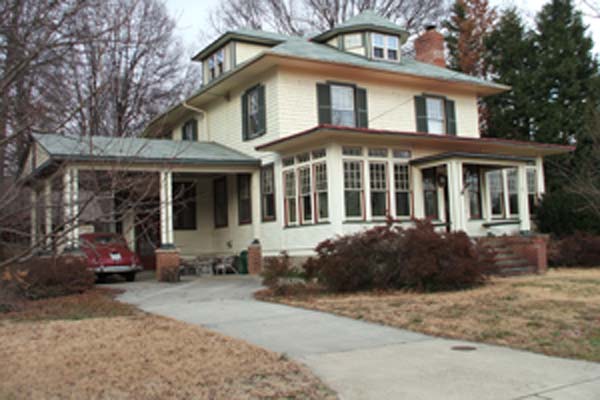 |
| Politics | Business | Schools | Justice | Health | Et Cetera |
Maryland Newsline Tuesday, Feb. 19, 2008 COLLEGE PARK, Md. – Some College Park property owners are finding the recent designation of Old Town College Park as an historic district more cause for dismay than celebration. The Prince George’s District Council gave final approval last month, with an 8-0 vote, to the historic district’s creation. It’s the county’s second state-designated historic district, joining the Broad Creek Historic District in Fort Washington, established in 1985. “It's important to preserve the integrity of the architecture. It's part of what makes the neighborhood special,” said Olsen, who abstained from the council vote because he worked on behalf of the district’s creation while a member of the College Park City Council. The 25-square-block, mostly residential neighborhood was established in 1889, just east of what was then the Maryland Agricultural College, and what's now the University of Maryland. A part of the town of College Park, the historic district is made up of 295 structures in a range of styles -- from Craftsman to Queen Anne, Colonial Revival to Cape Cod and modern. The historic district -- bounded on the east by Bowden Avenue, on the west by Yale Avenue, on the south by Calvert Road and on the north by Norwich Avenue -- is meant to help control development and preserve the character of the neighborhood. But some property owners view the designation as an interference with their rights and say they resent the logistical and financial burdens they believe it will impose. “Unfortunately, the city is continuing to use the historic district as a zoning tool,” said Lisa Miller, president of the Prince George’s County Property Owners’ Association. “They've harmed various property owners and ticked at lot of people off.” The establishment of the historic district won’t prohibit new construction or improvements for safety or give the county any authority over exterior paint colors or interior modifications, said Elisa Vitale, a planner with the city of College Park. But it does impose some restrictions on set-backs, replacement of materials permitted on exteriors, and the size and scale of buildings, she said. Before property owners in the district undertake demolition, construction or major alterations, the district’s design guidelines require that they submit a historic area work permit, which will be reviewed for approval by the county’s Historic Preservation Commission. Owners of "contributing" properties in the historic district may also be eligible for county, state or federal tax credits for the cost of preservation or rehabilitation work, said Howard Berger, planner coordinator with the Maryland-National Capital Park and Planning Commission’s Historic Preservation and Public Facilities Planning Section. “Contributing” resources -- according to the historic district’s Design Guidelines Handbook -- are those built within the “periods of significance” – 1889 to 1950, and 1935 to 1965. "Non-contributing resources" are those built later, or which have been “altered beyond their ability to convey the character of their historical period," Berger said. Creating the two categories allows the district to retain a fairly uniform shape while acknowledging that some properties within it more accurately convey the character of its periods of significance than others, Vitale said. The distinction also allows for more flexibility regarding the use of materials that would be permitted for exterior work on non-contributing properties, Berger said. Andrea Hawvermale, who owns six properties in the district, five of them non-contributing, said she is concerned that the permit process will make doing repairs after storm damage unnecessarily expensive and time-consuming. “Why should I have to follow all these rules and not benefit from it?” she said. Homeowner Miller also took issue with the way the district’s boundaries were drawn. "Almost everything that the city owns has been conveniently excluded," said Miller, who owns 11 properties within the Old Town historic district, 10 of which are listed as non-contributing resources. About 28 percent of the structures in the district have been designated as non-contributing, according to the Design Guidelines Handbook. "The fact that a third of the homes are non-contributing, just how historic is this district?" asked Hawvermale. The ratio of contributing to non-contributing properties “doesn’t mean anything,” Berger said. “There’s not a mathematical formula for … what makes it historic,” he said. Maryland Newsline's Tamra Tomlinson can be reached at ttomlins@umd.edu.
|
||||||||
|
Copyright © 2008 University of Maryland Philip Merrill College of Journalism | ||||||||
| Politics | Business | Schools | Justice | Health | Et Cetera | |||
